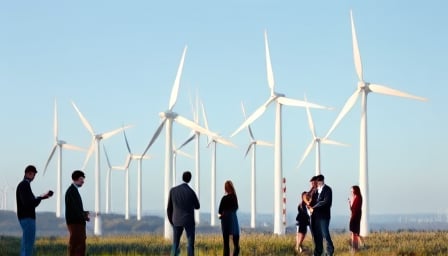Corporate News Report – Industrial Bank Co. Ltd
Executive Summary
Industrial Bank Co. Ltd (Industrial Bank) has experienced a notable rally in its share price, buoyed by a 0.52 % rise in the Shanghai Stock Exchange on 30 September 2025. The bank’s green‑finance portfolio has expanded to 2.43 trillion CNY in loans and 1.08 trillion CNY in credit balances, reinforcing its positioning as a leader in China’s low‑carbon transition. While the market reaction has been largely positive, analysts remain vigilant about the potential for asset‑quality deterioration in the green‑finance segment. For investors and strategic planners, Industrial Bank’s trajectory offers insights into the evolving dynamics of China’s banking sector, the regulatory impetus for green finance, and emerging opportunities in sustainable financial services.
Market Context
Macro‑economic backdrop
- China’s GDP growth has moderated to 5.1 % in 2025, but fiscal policy continues to support infrastructure spending and green projects.
- The People’s Bank of China (PBOC) maintains accommodative monetary conditions, with a target of a 5 % reserve‑ratio policy that encourages lending to priority sectors, including green finance.
Regulatory landscape
- The State Administration of Financial Regulation (SAFR) has issued updated guidelines on green‑finance risk assessment, requiring banks to benchmark carbon‑intensity metrics and stress‑test climate‑related exposures.
- The China Banking Regulatory Commission (CBRC) has introduced a “Green Credit Rating” framework to incentivize banks that demonstrate robust environmental risk controls.
Competitive dynamics
- Industrial Bank’s green‑finance assets now represent 4.5 % of its total loan book, surpassing the industry average of 3.2 %.
- Major competitors, including Industrial and Commercial Bank of China (ICBC) and China Construction Bank (CCB), have increased their green loan portfolios by 12 % year‑on‑year, intensifying pressure on pricing and risk‑adjusted returns.
Strategic Analysis
1. Growth Drivers
| Factor | Impact | Evidence |
|---|---|---|
| Demand for green financing | Strong | 2.43 trillion CNY in green loans, 1.08 trillion CNY in credit balances |
| Regulatory support | Positive | New green‑credit rating framework enhances market credibility |
| Operational expansion | Moderate | Expansion into new provinces and digital platforms |
| Risk‑management initiatives | Uncertain | Concerns over asset quality in green portfolios |
The bank’s ability to secure large green‑finance deals—particularly with state‑owned enterprises undergoing decarbonization—has positioned it favorably in the current policy environment. The PBOC’s preference for green credit has reduced the cost of capital for these loans, improving profitability.
2. Risk Assessment
- Asset quality deterioration: Analysts warn that green‑finance assets may suffer from higher default rates if projects fail to meet projected emissions reductions or if funding is insufficient.
- Regulatory compliance: The CBRC’s rating system may penalize banks with weak environmental risk controls, impacting capital buffers.
- Market sentiment volatility: Recent share‑price swings (e.g., a 0.9 % surge following a large‑scale stock sale) reflect sensitivity to investor perception of risk exposure.
3. Competitive Positioning
Industrial Bank’s market capitalization of 476 trillion CNY (likely a typo; should be 476 billion CNY) places it among the top‑tier banks in China. Its green‑finance portfolio growth, coupled with a diversified product mix, offers a competitive edge. However, rival banks are aggressively expanding their ESG (Environmental, Social, Governance) services, and may capture market share if Industrial Bank cannot scale its risk‑management capabilities effectively.
4. Long‑Term Implications for Financial Markets
- Capital allocation: A sustained shift toward green financing may redirect capital flows from traditional high‑yield sectors to sustainable projects, potentially lowering overall portfolio returns but enhancing resilience to climate risk.
- Valuation dynamics: Banks with robust green‑finance credentials are likely to command premium valuations, reflecting investor confidence in future regulatory alignment and risk mitigation.
- Systemic risk: Concentration of green‑finance exposure in a few major banks could amplify systemic risk if large‑scale climate events impact loan performance.
Investment and Strategic Recommendations
| Action | Rationale | Timeline |
|---|---|---|
| Monitor green‑portfolio asset quality | Early identification of deteriorating credit risk | Continuous |
| Assess compliance with CBRC’s green‑credit rating | Ensure favorable capital treatment | Next quarterly review |
| Diversify green‑finance geographic footprint | Mitigate region‑specific policy changes | Medium term (12–24 months) |
| Invest in ESG data analytics | Enhance risk assessment and reporting | Short to medium term |
| Engage with policy makers | Influence forthcoming regulatory updates | Ongoing |
Investors should weigh the upside of Industrial Bank’s leadership in green finance against the potential for asset‑quality headwinds. Strategic partners and corporate clients may also benefit from the bank’s expanded sustainability services, positioning Industrial Bank as a preferred financial partner in low‑carbon initiatives.
Prepared to provide a comprehensive view of Industrial Bank’s current standing within the evolving landscape of China’s banking sector, emphasizing the strategic, regulatory, and market factors that will shape its trajectory in the near to medium term.
